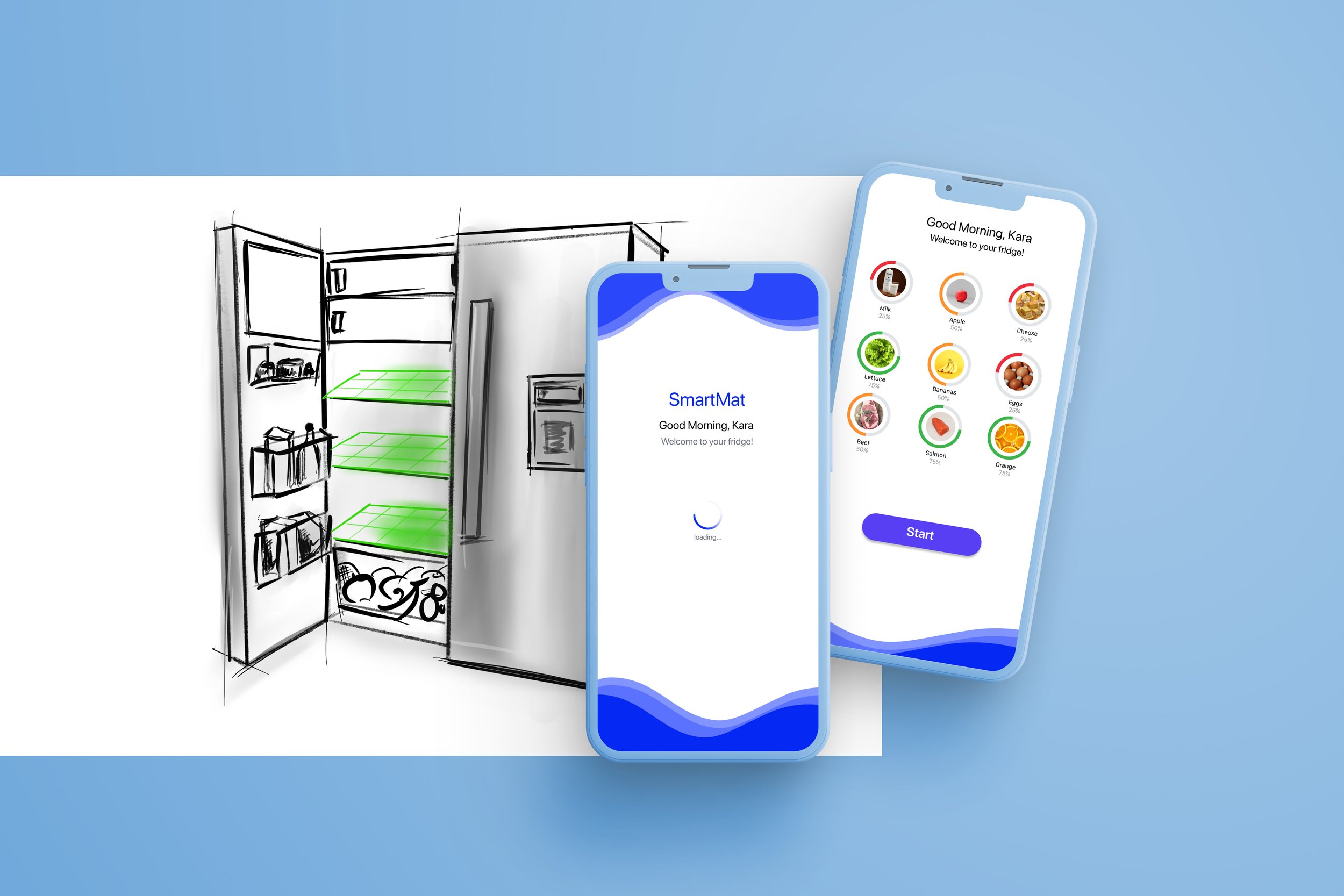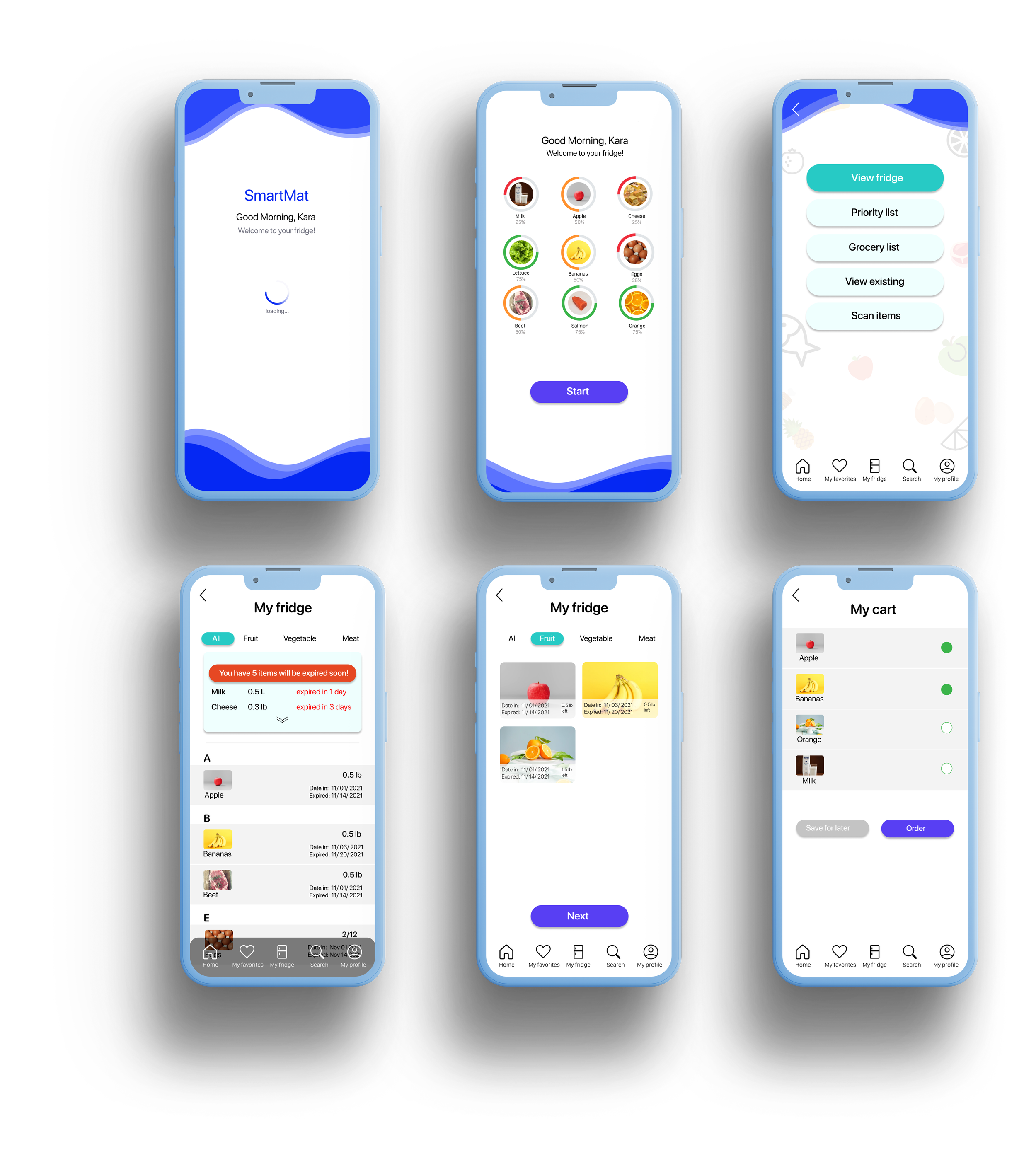
SmartMat
Overview
About
SmartMat is designed to retrofit traditional refrigerators with new features to gain some smart fridge functionality. This is a cost-effective solution, enabling users to stay organized and avoid wasting food. This design can connect with a mobile app to detect what items need to be used first, what items are going to expire soon, and it can remind users what items are running low.
Goal
The goal was to help users avoid wasting food, reduce stress, and access smart features without buying a new smart refrigerator.
My Role
Product Design
Duration
6-Week Project
Deliverables
3D model
An interactive mobile prototype
Discovery Research
To understand user needs and problems, I conducted generative interviews. I wanted to learn how users' needs are currently being met, why the current solution is not meeting their needs properly, and also validate my assumption.
Secondary Research
I then conducted a competitive analysis to learn what is currently on the market, the technologies that are currently used, and how the problems are currently solved.
I looked into Samsung, Haier, and LG Electronics smart refrigerator products. While these products do have smart features, it is accomplished by essentially embedding an iPad into the fridge. Also, the price is very high and varies from $3500 to $8000. Importantly, during user research, all of the participants mentioned that they would not discard their current working fridge and spend that much money on a new smart fridge.
Primary Research
At this phase, I wanted to discover user pain points and frustrations with the current products. I also wanted to learn users' concerns and how they organize their fridges so that I can find a way to help them utilize space and avoid wasting food.
I created an interview guide to make sure I obtained consistent information from the five participants.
Interview questions:
Do you own a smart fridge? If yes, do you like it?
If not, do you want to get one? Why?
How do you organize your food/produce after grocery shopping?
What kind of fridge products are you concerned about?
Can you describe your experience when using the fridge?
What are additional functions or features you want to have?
What are the things that you wish to have that could help you manage your produce better?
How satisfied are you with your fridge? If unsatisfied, what do you dislike about it?
Synthesizing Data
Top 4 Themes:
Suggest to the user what needs to be purchased and what needs to be used first
Be able to create a shopping list based on items in the fridge and the option to buy these items online
Organize food better [based on food categorized / coded system]
Inform the user which store has promotions or discounts
Personas
After user interviews, I created two personas from the two patterns
Journey Map
I broke the user journey into 5 stages: when the user buys and bring groceries home, arranges items in the fridge, check expiration dates on current items, creates a shopping list, and orders groceries online. At each stage, I defined user emotion, critical points and opportunities, solutions, and functionality
Value Proposition
Smart fridges have many great features but can be very expensive. Young professionals and college students often do not want to pay a lot of money to upgrade their current fridges. This product is designed to retrofit traditional fridges with new features to gain some smart fridge functionality. This is a cost-effective solution, enabling users to stay organized and avoid wasting food.
Ideation
Early phase | Group brainstorming
Initial sketches | exploring square-shaped refrigerator shelves
Exploring options
Final Sketches
Renderings
Mobile App
User Flow | Mobile App
Storyboard
Moodboard
Friendly, Minimal/Clean, Smart
Wireframing
Sketches
Sketching main keyframes for the app. User can see their fridge status once they log into the app. They can also check the status of the items in the fridge to see what is running low and what items are going to expire soon.
Low-Fidelity Prototype
splash screen
home
view all items
view my fridge
view fruit items
add to cart
High-fidelity Prototype
Lessons Learned
This concept design project helped me to explore not only designing physical objects but integrating them with a mobile app design. It was interesting to learn that was my assumptions were different from what my interviewees needed. It shows how important user input is during the new product development process. For instance, in the beginning, I wanted to design a smart fridge, however, after talking with users and doing secondary research, I decided to utilize the users' current fridges by retro-fitting smart functions.
Overall, I got positive feedback on the product idea, and the interviewees mentioned they would purchase the product. If I have more time I would explore the idea more by using 3D modeling of the product and usability tests of the mobile app. I would use this testing to validate and evaluate the app's functionality, ensuring that the app is ease-of-use and user-friendly.


























